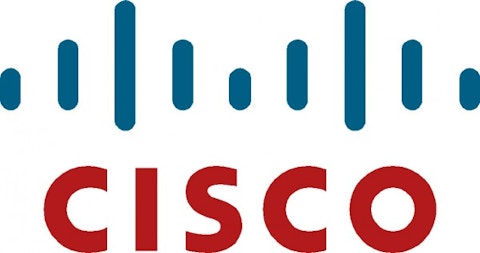Cisco Systems, Inc. (NASDAQ:CSCO), the networking giant, reported its Q2 earnings last week. Revenue grew by 5% on a year-on-year basis while net income grew 44% on the same basis. During the quarter Cisco returned a total of $1.2 billion to shareholders through a combination of share buybacks, totaling $500 million, and dividends, totaling $743 million. Free cash flow for the first two quarters has grown from $4.89 billion last year to $5.26 billion this year, growth of 7.7%.
Cisco has a long history of poor acquisitions, guilty of what Peter Lynch called ‘deworseification,’ but it seems that the company has become more focused on their core business. Cisco is selling Linksys, which it acquired in 2003, to Belkin for most likely less than Cisco originally paid for the company. Linksys sells routers and networking equipment aimed at homes while Cisco’s main competency is in the enterprise. Hopefully this ends Cisco’s attempts to expand into the consumer technology space, which have been a universal failure for the company.

A fortress balance sheet
Cisco, like many large tech giants, has an enormous amount of cash sitting on its balance sheet. At the end of Q2 Cisco had $46.3 billion in cash and cash equivalents and $16.3 billion in debt, a net cash position of $30 billion or $5.60 per share. With a current market price around $21 per share cash alone makes up a full 26.6% of the company’s total market capitalization.
A robust cash flow
Cisco is very good at making money. In fiscal 2012 Cisco recorded $10.3 billion in free cash flow. If we assume that the 7.7% growth for the first six months applies to the full year FCF for 2013 would reach about $11.1 billion. This is $2.07 per share, up from $1.91 per share in 2012.
Being a mature company Cisco will see most of its growth going forward come from acquisitions. But because the cash flow is so strong Cisco can grow per-share numbers considerably with share buybacks. With annual free cash flow at about 10% of the market cap, the company could boost earnings per share by 10% without growing at all.
Cisco started paying a dividend in 2011 and has grown that dividend to $0.56 per share annually since then. The payout ratio as a percentage of free cash flow is about 29%. Again, even without earnings growth, the dividend can be increased substantially. If free cash flow were to stay constant Cisco could raise its dividend by 10% annually for six years before the payout ratio hit 50%.
Data from Morningstar
How much is Cisco worth?
I’ll do a simple discounted cash flow calculation to estimate the fair value of a share of Cisco. For a discount rate I’ll use both 12% and 15% to define a fair value range.
Because projecting growth is difficult I’ll do this calculation for three different scenarios:
- No-growth – Free cash flow remains at the 2012 level indefinitely.
- Slow-growth – Free cash flow grows by 3% annually in perpetuity.
- Realistic-growth – Free cash flow grows by 6% annually for the next 10 years and 3% annually after that


